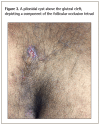What is hidradenitis suppurativa?
- PMID: 28209676
- PMCID: PMC5395382
What is hidradenitis suppurativa?
Abstract
Objective: To provide family physicians with an understanding of the epidemiology, clinical features, diagnosis, and management of hidradenitis suppurativa (HS).
Sources of information: A PubMed literature search was performed using the MeSH term hidradenitis suppurativa.
Main message: Hidradenitis suppurativa is a chronic, recurrent, and debilitating skin condition. It is an inflammatory disorder of the follicular epithelium, but secondary bacterial infection can often occur. The diagnosis is made clinically based on typical lesions (nodules, abscesses, sinus tracts), locations (skin folds), and nature of relapses and chronicity. Multiple comorbidities are associated with HS, including obesity, metabolic syndrome, inflammatory bowel disease, and spondyloarthropathy. Although the lack of curative therapy and the recurrent nature makes HS treatment challenging, there are effective symptomatic management options.
Conclusion: Family physicians should be suspicious of HS in patients presenting with recurrent skin abscesses at the skin folds. Family physicians play an important role in early diagnosis, initiation of treatment, and referral to a dermatologist before HS progresses to debilitating end-stage disease.
Copyright© the College of Family Physicians of Canada.
Figures



Comment in
-
Family physicians' role in hidradenitis suppurativa management.Can Fam Physician. 2017 May;63(5):352-353. Can Fam Physician. 2017. PMID: 28500191 Free PMC article. No abstract available.
References
-
- Jemec GB. Clinical practice. Hidradenitis suppurativa. N Engl J Med. 2012;366(2):158–64. - PubMed
-
- Sellheyer K, Krahl D. “Hidradenitis suppurativa” is acne inversa! An appeal to (finally) abandon a misnomer. Int J Dermatol. 2005;44(7):535–40. - PubMed
-
- Alikhan A, Lynch PJ, Eisen DB. Hidradenitis suppurativa: a comprehensive review. J Am Acad Dermatol. 2009;60(4):539–61. - PubMed
-
- Mebazaa A, Ben Hadid R, Cheikh Rouhou R, Trojjet S, El Euch D, Mokni M, et al. Hidradenitis suppurativa: a disease with male predominance in Tunisia. Acta Dermatovenerol Alp Pannonica Adriat. 2009;18(4):165–72. - PubMed
-
- Matusiak Ł, Bieniek A, Szepietowski JC. Hidradenitis suppurativa markedly decreases quality of life and professional activity. J Am Acad Dermatol. 2010;62(4):706–8. 708.e1. - PubMed
Publication types
MeSH terms
Substances
LinkOut - more resources
Full Text Sources
Other Literature Sources
Medical
Research Materials
